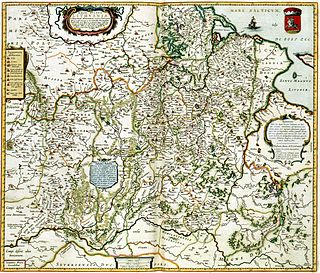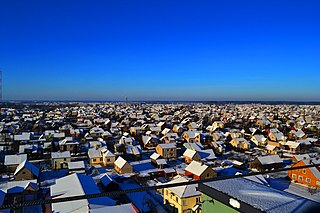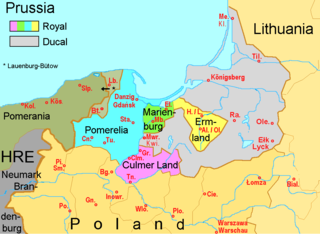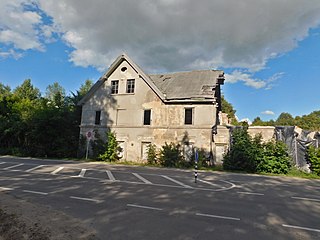
The history of Lithuania dates back to settlements founded about 10,000 years ago, but the first written record of the name for the country dates back to 1009 AD. Lithuanians, one of the Baltic peoples, later conquered neighboring lands and established the Grand Duchy of Lithuania in the 13th century. The Grand Duchy was a successful and lasting warrior state. It remained fiercely independent and was one of the last areas of Europe to adopt Christianity. A formidable power, it became the largest state in Europe in the 15th century spread from the Baltic Sea to the Black Sea, through the conquest of large groups of East Slavs who resided in Ruthenia. In 1385, the Grand Duchy formed a dynastic union with Poland through the Union of Krewo. Later, the Union of Lublin (1569) created the Polish–Lithuanian Commonwealth that lasted until 1795, when the last of the Partitions of Poland erased both independent Lithuania and Poland from the political map. After the dissolution, Lithuanians lived under the rule of the Russian Empire until the 20th century, although there were several major rebellions, especially in 1830–1831 and 1863.


Royal Prussia or Polish Prussia was a province of the Crown of the Kingdom of Poland, which was established after the Second Peace of Thorn (1466) from territory in Pomerelia and western Prussia which had previously been part of the State of the Teutonic Order. Royal Prussia retained its autonomy, governing itself and maintaining its own laws, customs, rights and German language.

Prussia was a German state located on the southeast coast of the Baltic Sea. It formed the German Empire when it united the German states in 1871. It was de facto dissolved by an emergency decree transferring powers of the Prussian government to German Chancellor Franz von Papen in 1932 and de jure by an Allied decree in 1947. For centuries, the House of Hohenzollern ruled Prussia, expanding its size with the Prussian Army. Prussia, with its capital at Königsberg and then, when it became the Kingdom of Prussia in 1701, Berlin, decisively shaped the history of Germany.

The Province of West Prussia was a province of Prussia from 1773 to 1829 and 1878 to 1920. West Prussia was established as a province of the Kingdom of Prussia in 1773, formed from Royal Prussia of the Polish–Lithuanian Commonwealth annexed in the First Partition of Poland. West Prussia was dissolved in 1829 and merged with East Prussia to form the Province of Prussia, but was re-established in 1878 when the merger was reversed and became part of the German Empire. From 1918, West Prussia was a province of the Free State of Prussia within Weimar Germany, losing most of its territory to the Second Polish Republic and the Free City of Danzig in the Treaty of Versailles. West Prussia was dissolved in 1920, and its remaining western territory was merged with Posen to form Posen-West Prussia, and its eastern territory merged with East Prussia as the Region of West Prussia district.

Lithuania Minor, or Prussian Lithuania, is a historical ethnographic region of Prussia, where Prussian Lithuanians lived, now located in Lithuania and the Kaliningrad Oblast of Russia. Lithuania Minor encompassed the northeastern part of the region and got its name from the territory's substantial Lithuanian-speaking population. Prior to the invasion of the Teutonic Knights in the 13th century, the main part of the territory later known as Lithuania Minor was inhabited by the tribes of Skalvians and Nadruvians. The land depopulated during the incessant war between Lithuania and the Teutonic Order. The war ended with the Treaty of Melno and the land was repopulated by Lithuanian newcomers, returning refugees, and the remaining indigenous Baltic peoples; the term Lithuania Minor appeared for the first time between 1517 and 1526.

The State of the Teutonic Order, also called Deutschordensstaat or Ordensstaat, was a medieval Crusader state, located in Central Europe along the southeastern shore of the Baltic Sea. It was formed by the knights of the Teutonic Order during the 13th century Northern Crusades in the region of Prussia. The Livonian Brothers of the Sword merged in 1237 with the Teutonic Order of Prussia and became known as its branch, the Livonian Order, while their state became a part of the Teutonic Order State. At its greatest territorial extent, in the early 15th century, it encompassed Chełmno Land, Courland, Gotland, Livonia, Neumark, Pomerelia, Prussia and Samogitia, i.e. territories nowadays located in Estonia, Latvia, Lithuania, Germany, Poland, Russia, and Sweden.

Tauragė is an industrial city in Lithuania, and the capital of Tauragė County. In 2020, its population was 21,520. Tauragė is situated on the Jūra River, close to the border with the Kaliningrad Oblast, and not far from the Baltic Sea coast.

Prince Michał Hieronim Radziwiłł was a Polish nobleman, politician, diplomat and member of the Polish-Lithuanian Radziwill family. He was a Knight of the Order of the White Eagle and a holder of the Order of the Black Eagle. His paternal great-grandfather was Dominik Mikołaj Radziwiłł.

Subdivisions of the Polish–Lithuanian Commonwealth evolved over for centuries of its existence from the signing of the Union of Lublin to the third partition.

The Catholic Church in Lithuania is part of the worldwide Catholic Church, under the spiritual leadership of the Pope in Rome. Lithuania is the world's northernmost Catholic majority country. Pope Pius XII gave Lithuania the title of "northernmost outpost of Catholicism in Europe" in 1939.

Dobrzyń Land is a historical region in central-northern Poland. It lies northeast of the Vistula River, south of the Drwęca, and west of the Skrwa. The territory approximately corresponds with the present-day powiats of Lipno, Rypin, and half of Golub-Dobrzyń within the Kuyavian-Pomeranian Voivodeship, although it encompasses parts of other counties as well. Totally, it has about 3,000 km2 and 200,000 inhabitants. Its historic capital is Dobrzyń nad Wisłą, which gave its name to the entire region. Its largest town is Rypin.

Herkus Monte was the most famous leader of the Great Prussian Uprising against the Teutonic Knights and Northern Crusaders. The uprising began in September 1260, following the Knights' defeat at the Battle of Durbe, and lasted for the next fourteen years.

The Pomeranian Voivodeship was a unit of administrative division and local government in the Kingdom of Poland and the Polish–Lithuanian Commonwealth from 1454/1466 until the First partition of Poland in 1772. From 1613 the capital was at Skarszewy.

Lauenburg and Bütow Land formed a historical region in the western part of Pomerelia or in the eastern part of Farther Pomerania. It was composed of two districts centered on the towns of Lauenburg (Lębork) and Bütow (Bytów). The land is today part of the Polish Pomeranian Voivodeship.

The Polish–Teutonic War (1326–1332) was the war between the Kingdom of Poland and the State of the Teutonic Order over Pomerelia, fought from 1326 to 1332.

Nemirseta is a district of the Lithuanian seaside resort Palanga, located on the Baltic coast north of Klaipėda. The place, which consists mainly of two deserted buildings which were formerly an inn and customs house, is notable for having marked for about five centuries the northernmost point of Prussia and the northeastern tip of the German Empire from 1871 to 1920.

Königsberg was the historic German and Prussian name of the city that is now Kaliningrad, Russia.

Pomesanians were a Prussian clan. They lived in Pomesania, a historical region in modern northern Poland, located between the Nogat and Vistula Rivers to the west and the Elbląg River to the east. It is located around the modern towns of Elbląg and Malbork. As the westernmost clan, the Pomesanians were the first of the Prussians to be conquered by the Teutonic Knights, a German military crusading order brought to the Chełmno Land to convert the pagans to Christianity. Due to Germanization and assimilation, Pomesanians became extinct some time in the 17th century.
























